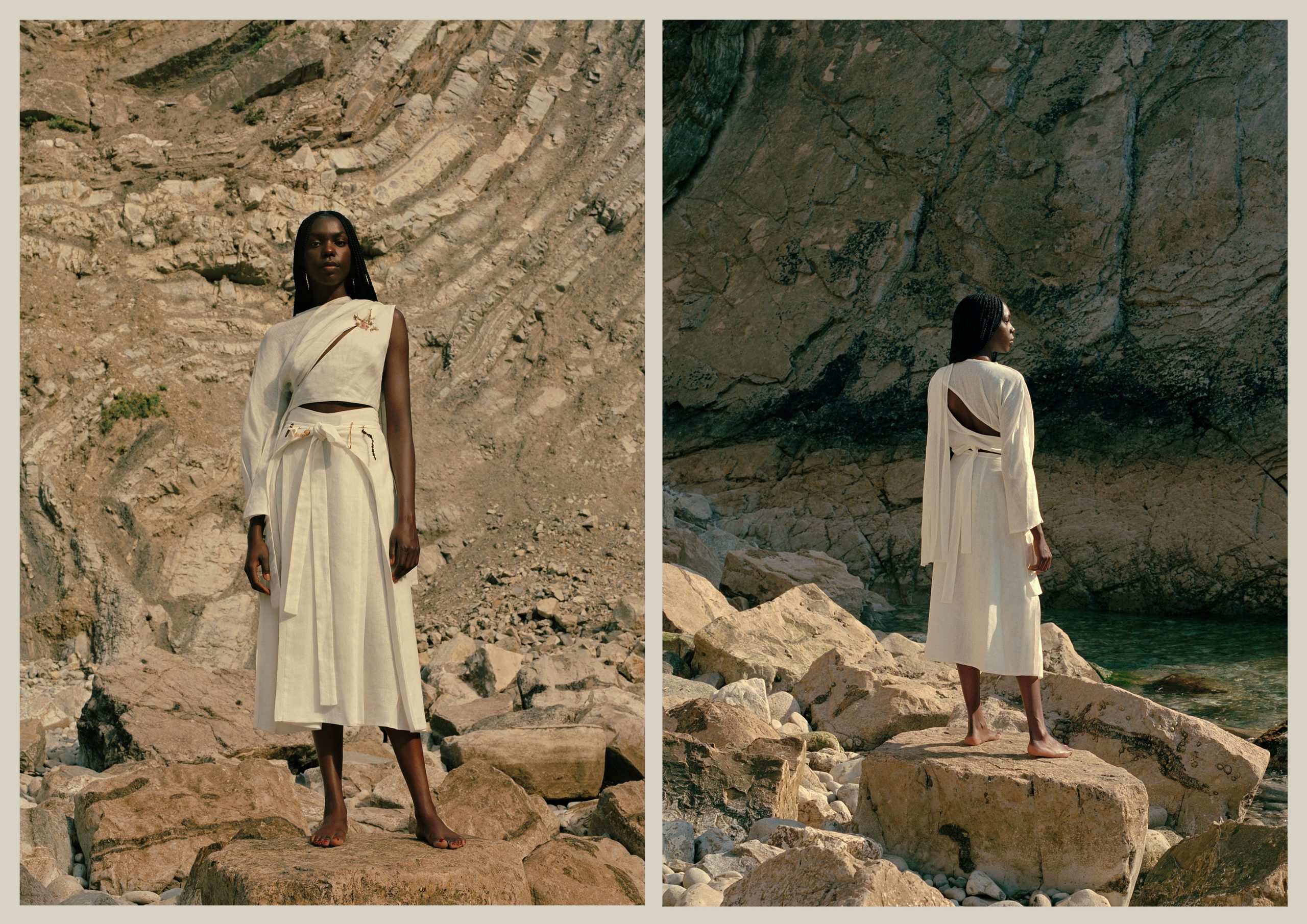Fashion is something that everybody, whether they acknowledge it or not, interacts with and expresses themselves through. Not just on an individual basis, but as societies, and across the world. I approach fashion as an extension of anthropology/ethnography/sociology and that’s what makes it compelling to me. But I also really love the making side, using my hands, experimenting with materials and techniques, and realising a vision to the end – building worlds. There is no better way to learn about the world than to use both your mind and your hands to experiment and create, in whatever medium that is relevant to your interests.
Every so often I come across bodies of work by designers that leave me truly astounded; moved emotionally, and into a transient space where my conceptual thinking around “fashion” is amplified. Azura Lovisa is one such designer; a being who walks between the cultural worlds of her heritage as Swedish and Malaysian, and whose clothing embodies a liminal space between dimensions – with a deep reverence for nature, ritual attire made accessible and transformed, and a thoughtfulness inextricably linked to the investigation and preservation of the multiplicity in her cultural identities. Drawing on the minimal Scandinavian design approach so imprinted in the lexicon of the Nordic region, while imbuing her collections with the profound nuances of South-East Asian traditions, Azura Lovisa moves fashion into the space it intends to reign; as a contemporary understanding of our ancient necessity for attire, making the strong case for dream-weaving with clothing as part of daily life. In understanding her approach, one has to look at fashion through the socio-ecological roots that dressing has had since the inception of humanities’ evolution as hominids. The requirement for clothing as environmental protection, yet a primal glimpse into the first signifiers of socialisation, whereby groups of humans were distinguished by realising their bodies as treasures chests; destined for adornment, a canvas for self-expression and freshly acquired craft abilities and skills.

This is the astounding contribution fashion, in its true sense of the word, as had on us; as the literal fibres with which our rich cultural developments are memorialised. Azura Lovisa offers the world a dreamscape in which adaptions of culture are woven into clean cuts, tempered by exquisite fabrics and gifted alongside talismans evoked from the medicinal traditions and folklore of her Malaysian/Swedish heritage. In my own understanding of my Swedish heritage, there is a deep mythological thread that remains embedded in the region; many of us still believing in the elemental spirits inhabiting the forests, compounded by folklore stories and animistic preservation of the land – particularly in the rural regions up north of the country. The same remains true for South-East Asia; and it relays a common sense in our species that we are indeed, a part of the natural world. This is in stark contrast to the emergence of mono-theistic traditions that separate humans from nature. Sustainability – protection of the earth – is our birthright, it is our sovereign inheritance from ancient times, and it is with this that I feel compelled to speak of Azura Lovisa’s work as an expression of the powerful way fashion can lead us back to our instinctive connection to sacredness; in Nature, in Identity and in Evolution.
I hope this interview opens up a world within you that dares to know your own heritage as robust, rich and full of wonders. I have only the deepest gratitude to Azura for this conversation.
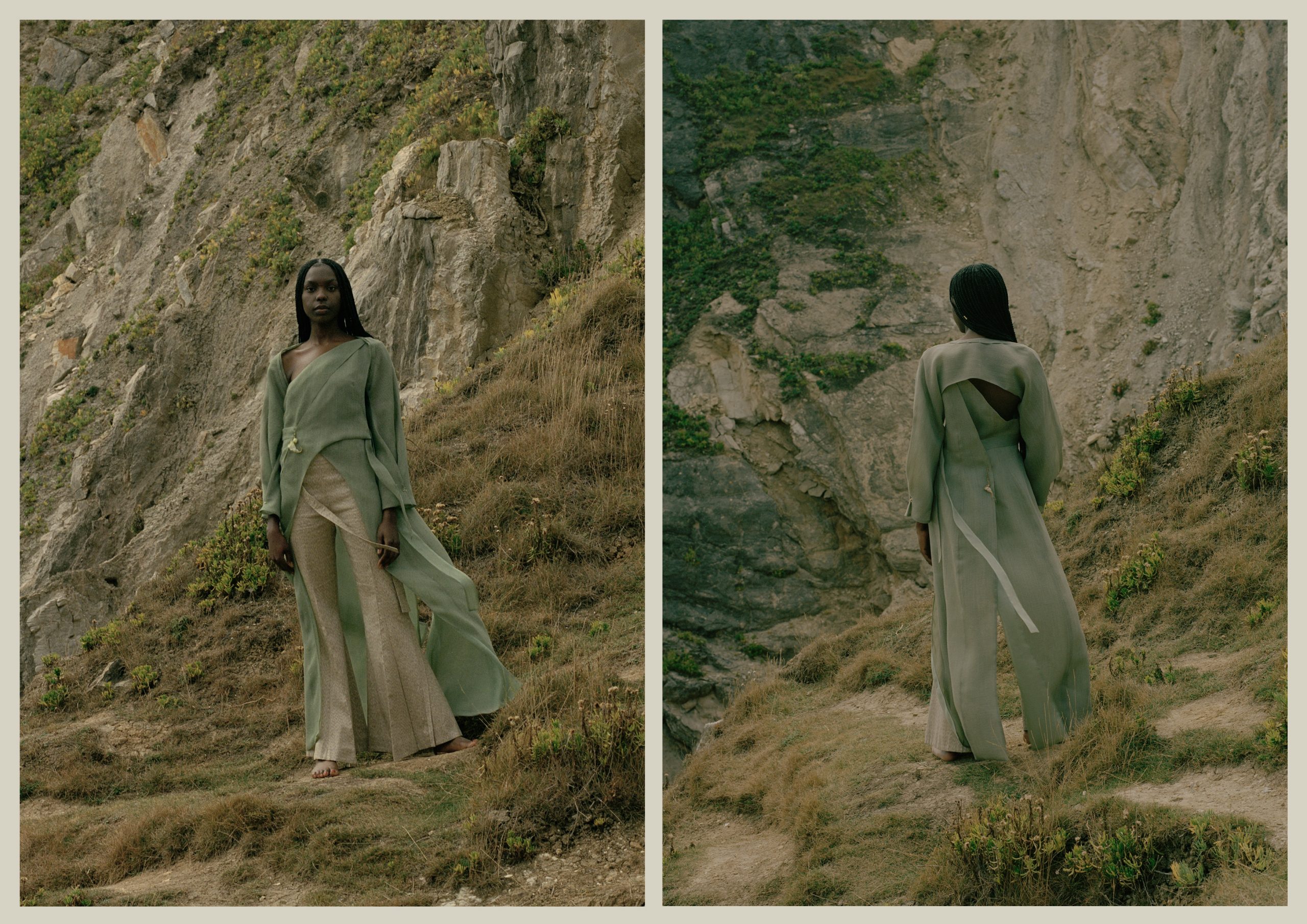
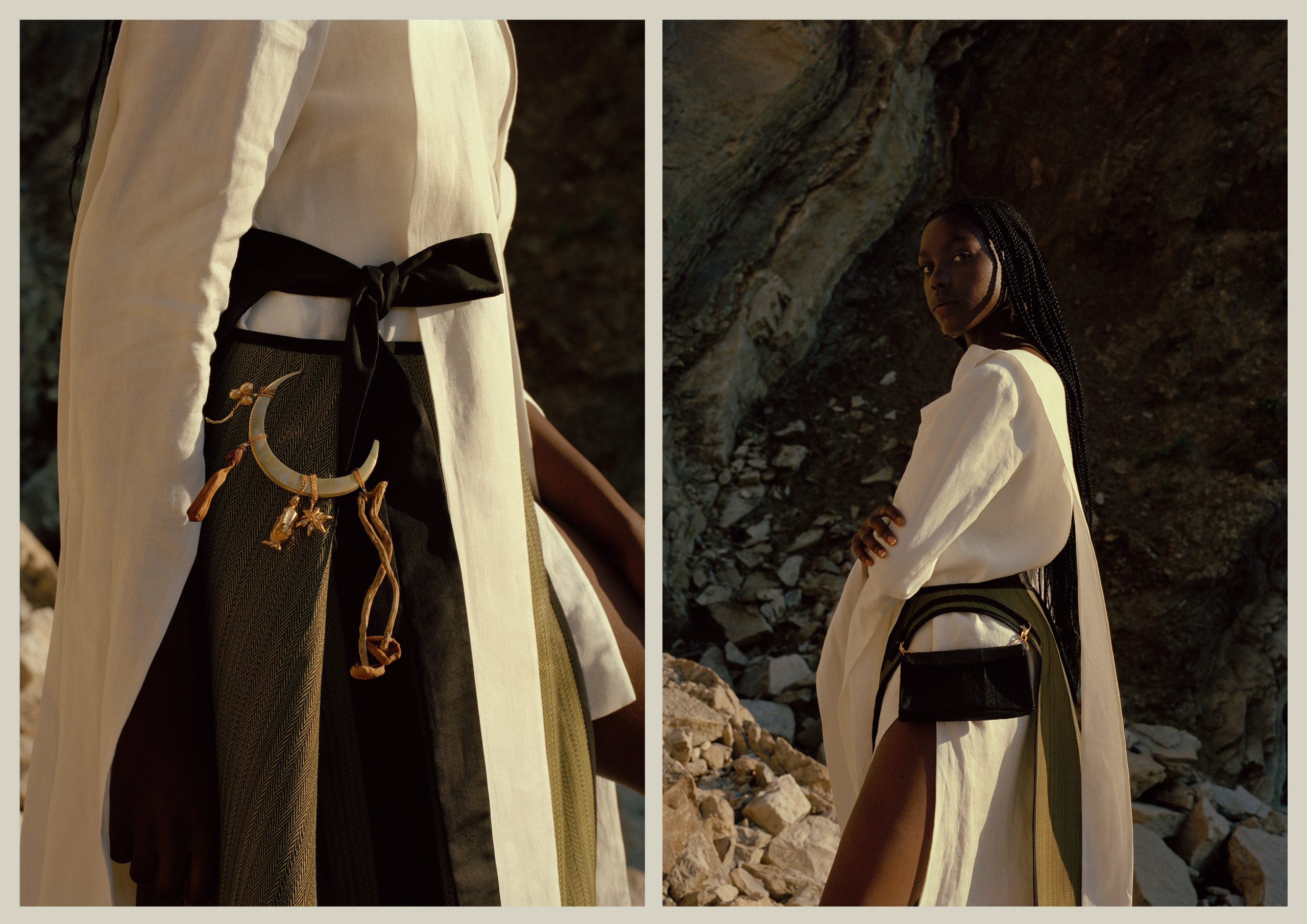
How did you come into being a designer, and viewing the world through the lens of pursuing creation?
Azura Lovisa: I’ve always had an interest in the arts and academia, and I suppose design is a natural convergence of the two. I enjoy exploring conceptual and aesthetic themes for the sake of art, but also theoretical, practical, and philosophical elements of design rooted in real life applications. In high school I was lucky to attend a public arts magnet high school in Miami, Design and Architecture Senior High. Alongside a rigorous academic program we practiced 2D and 3D arts alongside various arts electives, and all students also selected a design pathway. I chose fashion because even then I was drawn [to] fashion’s power to shape our sense of self and to influence and reflect cultural currents. Fashion allows us, as artists, to extend beyond our own expression and involve the audience in the life of a work. Once it leaves the studio and is worn by another individual, it becomes part of their story – the narrative is no longer in my control, and that’s quite exciting. The body is the forum where ideas intersect with culture and lived experience. Fashion is something that everybody, whether they acknowledge it or not, interacts with and expresses themselves through. Not just on an individual basis, but as societies, and across the world. I approach fashion as an extension of anthropology/ethnography/sociology and that’s what makes it compelling to me. But I also really love the making side, using my hands, experimenting with materials and techniques, and realising a vision to the end – building worlds. There is no better way to learn about the world that to use both your mind and your hands to experiment and create, in whatever medium that is relevant to your interests.
Your label manifesto talks about “clothing mythology”; could you elaborate on what this means, and what informs the mythological aspect of your work?
Azura Lovisa:I’ve been drawn to fantasy and folklore since I was a child in Northern Sweden, as it’s quite embedded into the culture, especially in areas surrounded by nature. As an only child I was also in my head a lot growing up, so I tended to mythologize my own experience, especially my early childhood after I moved away from Sweden. My relationship to my Malaysian heritage was also largely shaped by stories told to me by my mother. Mythology – both in a historical folkloric sense and in the contemporary mythologies we create – is an essential part of world building. It’s the stories we tell ourselves about who we are and what gives value to our beliefs and pursuits.
So “clothing mythology” has a double meaning: clothing, as a verb, as in to clothe mythology itself and mythical figures – creating garments I imagine otherworldly beings wearing; and clothing mythology, as in the mythology of clothing, which is something people often forget – the spiritual and metaphysical qualities of clothing and how important they once were as an element of ritual and identity formation. There’s a quote by Katharine Hamnett: “The origins of clothing are not practical. They are mystical and erotic. The primitive man in the wolf-pelt was not keeping dry; he was saying: Look what I killed. Aren’t I the best?” Clothing can transform us and outwardly mirror who we believe ourselves to be on the inside. They open portals, they empower us and invite us to step into our fantasies. They stir up emotions and evoke memories. And, in the case of handwoven fabrics (which I mostly work with), stories and cultural heritage is woven into the cloth itself. “Clothing mythology” encompasses the narratives embodied in the physical garments, as well as recognising clothing’s significance in our own stories and dreams.
Clothing is the most immediate outward expression of identity, of how we relate to our community and facets within it, of our place in the larger constellation of figures and meanings and events in time. I hope that reasserting the value of ritual – rituals of dressing, of becoming, of everyday existence – can show us that the magic we imagine the mythological past as being imbued with is not beyond us in contemporary times. It just means being intentional about the way we project ourselves, the way we honour our histories, and how we cultivate and expand our perspectives. It means taking the time to be, to think about the significance of our actions and how we communicate our spirit, and how the way we dress is an opportunity to channel more than just an aesthetic or a trend that follows a (Western) globalised current. We aren’t obligated to reject anything, but we should be mindful of everything. We can choose to imbue the ordinary with mythological significance and to write stories with our bodies.


Your label embodies such a complexity in the union between Scandinavian design and Southeast Asian aestheticism; how do you balance these two intrinsic aspects when designing?
Azura Lovisa: I’m from northern Sweden, and we are people with deep reverence for the forests, waters, mountains. The Scandinavian philosophy of life is one that is simple, elemental, and bound to nature. This grounds me, and I associate a lot of my perceived integrity as a creator with honouring the lessons I have learned in nature. My designs are not really minimalistic per se, which many people associate with Scandinavian design, but really the central tenets are not merely simplicity but humble materials, balance, naturalism, and pragmatism. This in turn shapes how I approach my investigation of Southeast Asian aesthetics and cultural traditions, and more specifically the references and elements of heritage shared across Malaysia, Singapore, Indonesia, and Thailand. The amalgamation of Eastern and Western influences are very much a reflection of my own experience – through the eyes of a mixed-race woman who has grown up in the West, largely outside of both countries of origin as I spent most of my youth in the multicultural metropolis of Miami. I can only perceive Southeast Asia through this lens of hybridity, and at the same time it is the very condition of hybridity I am interested in, rather than some purist idealisation of traditional forms.
If I were to simplify things I could think of the differences between Scandinavian and Southeast Asian aesthetics as elemental – they feel cool and warm, respectively. Scandinavian influence feels open, sparse, bare, pragmatic – it reflects the codes of the landscapes. I think of the tundra, exposed rock, moss, birch forest. Things are very stripped down, bare essentials, humble – subsumed within nature. In contrast, Southeast Asian influence feels abundant, earthy, complex – it reflects the jungles, the density of life, humid fragrant nights, the heat and sun. There is a lot of ornament, warmth, celebration – the exuberance of nature. The balance of seemingly opposing energies and influences happens quite naturally because I have always been comfortable in spaces of cultural collision and multi-ethnic, transcultural exchange. I’m not consciously trying to visually push one influence or the other, it’s a flow.
I am fascinated by “fashion”, in terms of expression, as a form of storytelling – what narratives inspire you thematically in terms of telling a story through garments?
Azura Lovisa: I’m really drawn to family histories, tales of the seemingly mundane every day and the in between moments that contain beauty and tenderness. The poetry that runs through a life, that we, generations later, hear retold and begin to understand who the people in our lives were and are. One of the most beautiful things in life is looking through old photographs in a dusty album with loved ones. So many dreams, laughs, struggles, tragedies, evolutions, revolutions. And clothes, they are part of what gives texture to these lives. They communicate through the photographs what the subject, mute and frozen in time, can only hint at in the expression of their eyes. They locate a memory in time and describe an era. They give depth to a chapter in life, clothe ghosts and former selves.
That’s not to say I only am interested in narratives that look back into the past. Clothes can present a vision of the future. It comes back to the idea of “clothing mythology” and the power of world building. At present it’s difficult for our imaginations not to drift towards the dystopian, and the narratives I am looking to explore further are definitely centred in a natural world touched by the conflicts and climate emergencies caused by humanity’s fatal failure to see itself as an inseparable part of nature rather than outside of it or in opposition to it – humanity within nature, rather than its master. But I am trying to be hopeful and follow the mindset of what artist Ayesha Tan-Jones calls “optimystic dystopia.” I really love that perspective; it’s a narrative that recognises the harsh future we are facing while still leaving room for resistance and agency.
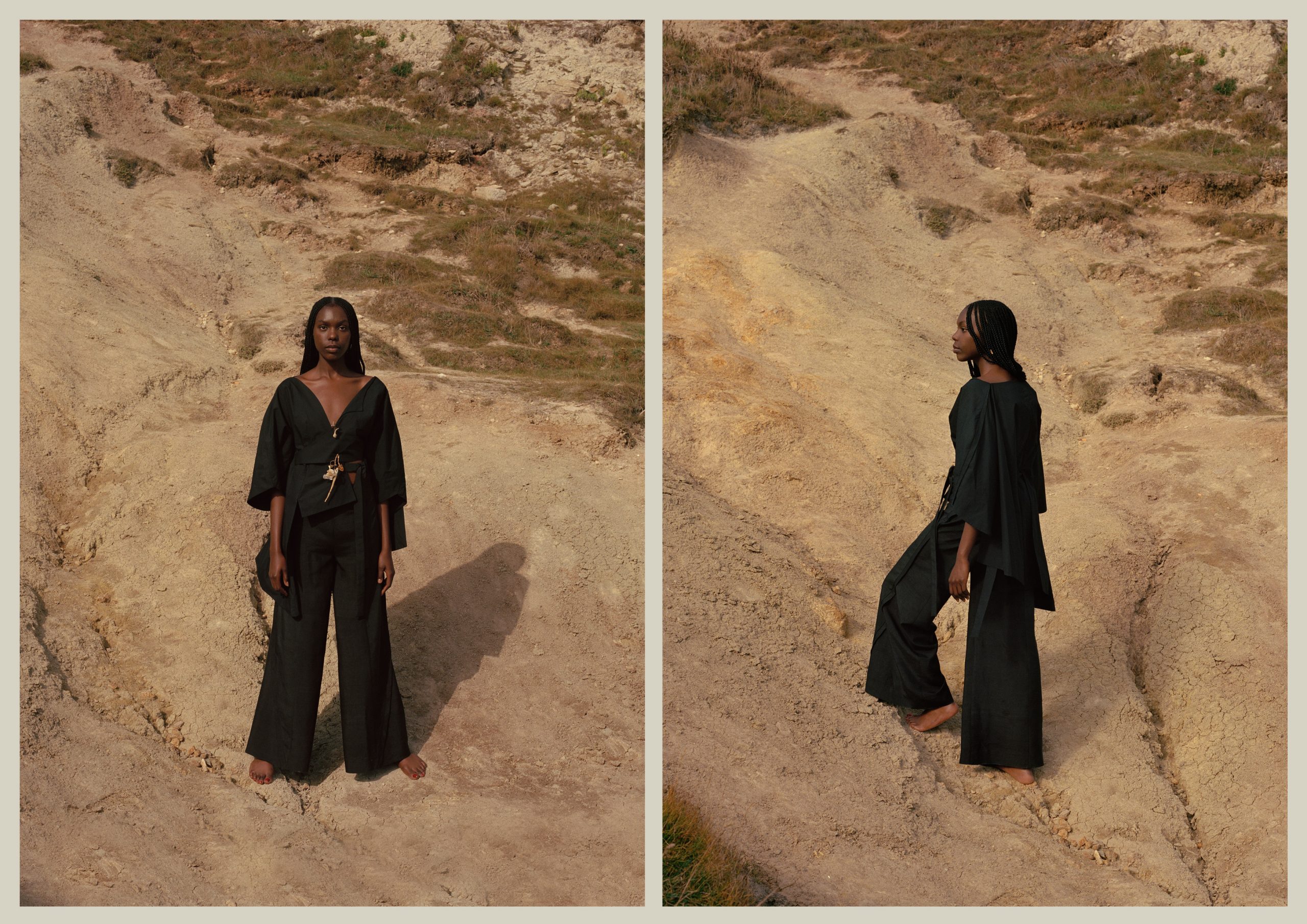
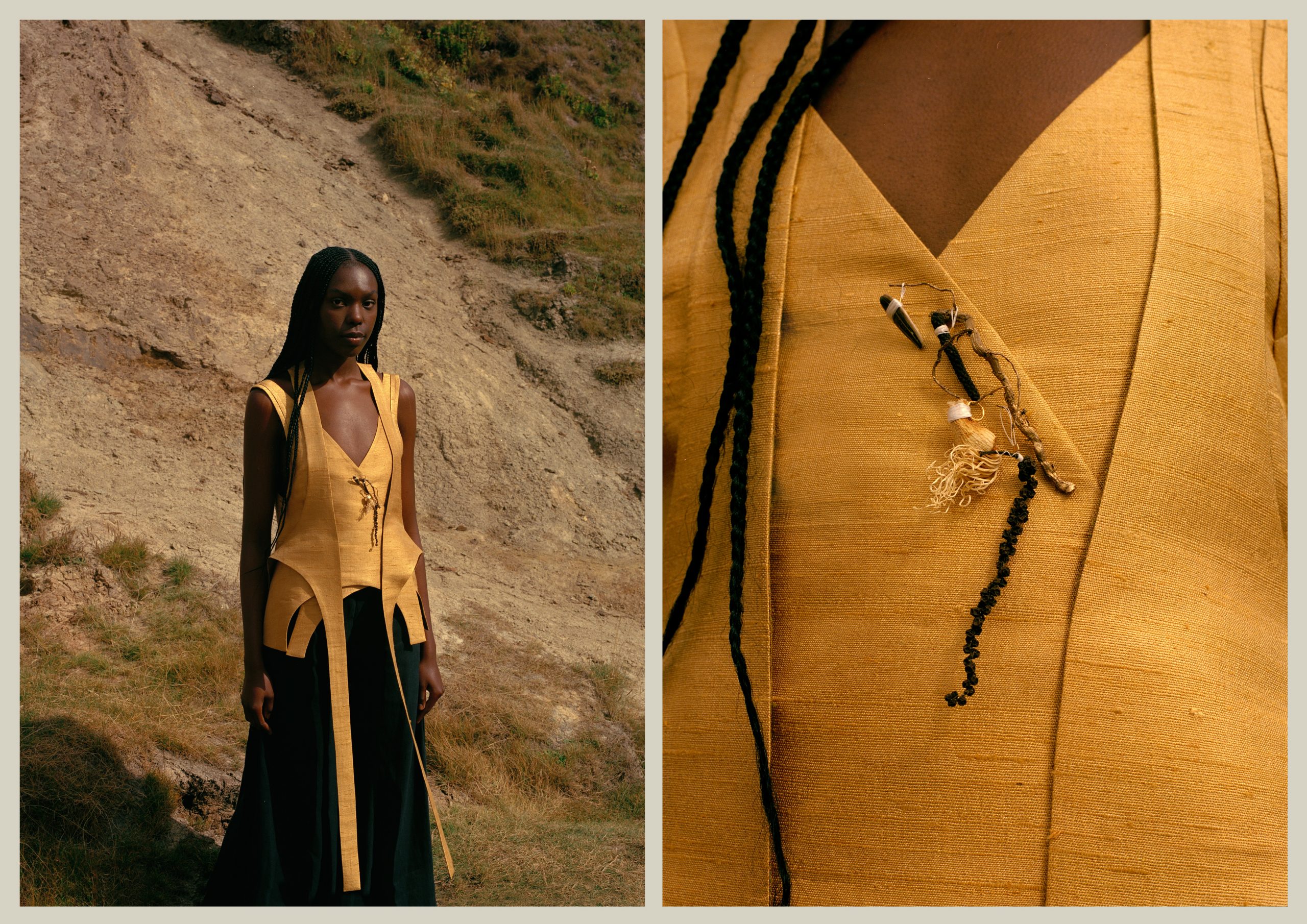
Sustainability is woven into Azura Lovisa so seamlessly; what are the ethical values that underpin your approach to forging a contemporary label?
Azura Lovisa: Sustainability is a responsibility for all designers, and there are many ways to approach it. For me it was important to approach it from a human angle rather than strictly thinking about circularity, recycling or up-cycling, as while I think there are many amazing sustainable technologies and techniques emerging that make positive change for the planet (and we should certainly aim for circularity), we should be mindful of how we as Westerners impose on or interact with so-called developing or “Third World” nations that are in many cases already paying heavy prices for climate change initially driven by the West. Our solutions for sustainability must be sensitive to specific local and cultural complexities and situations. Real change will come from addressing issues on the ground and working directly with makers and communities to make changes they can see in their own backyards, in places that are often neglected by the world. Greenwashing often further marginalises people in other parts of the world that rely on textiles and craft to survive, whose traditional techniques are inherently sustainable and respectful of the Earth. Without a doubt, we create too much, but the main problem is that we create things without meaning, we create things that are born trash and die trash, in a faraway landfill. But textile art forms have significant value, for the makers and their communities but also for us, as consumers. Handwoven textiles are alive. They are future heirlooms, rich with history and meaning.
Intimacy with Earth, from concept to creation, is a core value for me. I believe it is essential to slow the pace of production and consumption, and to consider the human and socio-political aspects of sustainability and approach it from an anti-colonial perspective. Shifting towards ways of making that respect traditions in tune to specific local environments works from the inside to decrease reliance on foreign imports and toxic systems that deplete resources and throw ecologies into imbalance. We believe the interconnectivity of communities and culture with the land is an integral part of regenerative and holistic care for the environment. My designs feature handwoven heritage textiles sourced from cottage industries and weaver-owned businesses, empowering rural communities in South and Southeast Asia while sustaining legacies of traditional craft. We prioritise the people whose histories are tied to a heritage of weaving, recognising the symbiosis between the environment and the hands that tend to it. Supporting makers means supporting ways of life that have adapted to a specific place’s conditions and cycles.
Please tell me about the jewellery aspect; the charms and spells interlaced into the offering of the label — what is the motivation behind adding such sentimentality alongside the garments? It is so thoughtful and beautiful.
Azura Lovisa: Thank you! For the last collection, in collaboration with jewellery designers Tanaporn Wongsa and Birgit Frietman, we created a series of modular brooch / earring hybrids and interchangeable charms. The jewellery references the Malay folk magic practice of susuk, the ancient art of embedding charmed gold needles and diamond shards under the skin as talismans, as well as other traditional practices which often enact the use of plant-based ingredients like roots, flowers, and spices. The gold brooches, some in a crescent shape and others cast from roots, are adorned by an assortment of charms in their raw organic forms as well as electroformed and gold plated. I became interested in charms and spells in traditional Malay and Thai medicine (though it exists in similar forms across Southeast Asia and of course in other regions across the world in localized variations) through conversations with my mother that led me deeper into this research. She revealed to me that she herself had susuk charms embedded in her body in her youth, under the guidance of her brother who was very involved in folk magic and regularly visited with a traditional bomoh shaman. This type of magic is not something to take lightly – it must be respected and learned, and as an outsider I don’t feel it’s my place to delve too deep while I’m uninitiated. However, we took inspiration from the aesthetic approach and handling of the organic materials and rather than referencing specific spells or practices, we applied this reverence for nature’s medicines and symbols to the forms we were drawn to and designed the pieces in a way where the arrangement of charms in combination with the brooches could reflect the wearer’s own interests and they could feel they were crafting their own personalised spells in a way. I’ve always been a collector of objects found in nature myself, and I think the forms we are drawn to say a lot about us and what we are seeking.
What future vision are you holding for yourself, and the label?
Azura Lovisa: I aspire to grow Azura Lovisa into a slow fashion brand with global presence, anchored by respect for multiculturalism, authenticity, craftsmanship, storytelling, and sustainability. We will keep collections concise and scale responsibly while strengthening relationships with craftspeople and hand weaving communities in South and Southeast Asia and working with socially responsible creative initiatives that provide autonomy and support to the makers, who in turn care for their community and environment. I want to work with farmers to encourage practicing regenerative agriculture, create new links with communities whose traditional ways of life are threatened, and collaborate with community leaders on the ground to develop programs and provide opportunities.
Anchored in the world of fashion I also plan to extend into film, writing and publishing, art exhibitions, curation and programming, other areas of design, and social missions – all unified and guided by the brand’s ethos. I’m excited to collaborate with artists, writers, researchers, curators, and performers to expand the world of Azura Lovisa into new dimensions. I want to build a core community around the brand, inviting the public to explore and contribute to a research database and educational platform where the brand’s inspirations and references can live on. I also hope to collaborate with museums, research groups, and universities. Fashion is a force rich in cultural currency, and using that influence in the service of cultural education is a priority.
